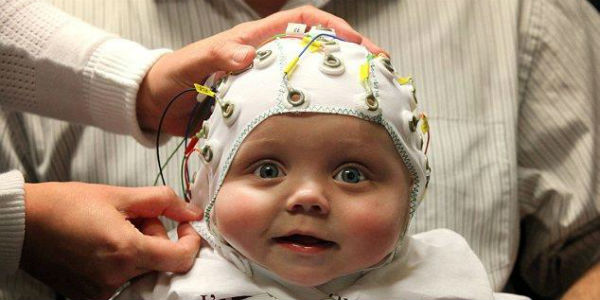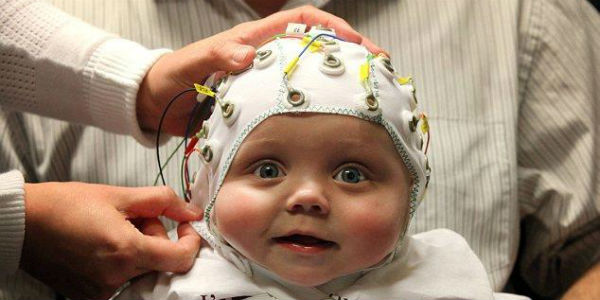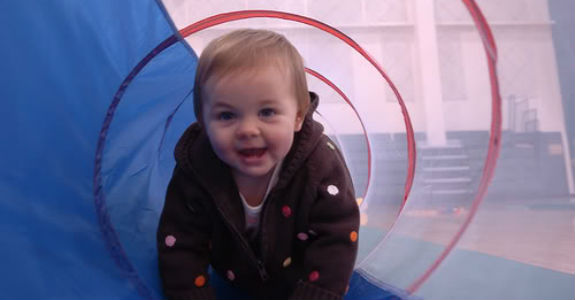
Therapy Tips  Although autism is generally diagnosed around age three, speech-language pathologist Dr. Rebecca Landa of the Kennedy Krieger Institute believes delays in communication, social skills and motor skills can be recognized as early as 14 months. If a diagnosis can be made earlier, when the child’s brain is more malleable and still developing circuitry, treatment can begin with increased positive outcomes.
Parents should watch for the following 10 symptoms when their child is between six and 12 months old and contact their pediatrician or other developmental expert if occurrences are noted. If you feel that something is wrong, take action immediately rather than a “wait and see” approach.
Although autism is generally diagnosed around age three, speech-language pathologist Dr. Rebecca Landa of the Kennedy Krieger Institute believes delays in communication, social skills and motor skills can be recognized as early as 14 months. If a diagnosis can be made earlier, when the child’s brain is more malleable and still developing circuitry, treatment can begin with increased positive outcomes.
Parents should watch for the following 10 symptoms when their child is between six and 12 months old and contact their pediatrician or other developmental expert if occurrences are noted. If you feel that something is wrong, take action immediately rather than a “wait and see” approach.
 Scientists believe abnormal development may be detected in brain scans as early as 6 months, even before other signs are noted. Dr. Alan Evans of McGill University in Montreal is working to develop “at risk” biomarkers for autism.
In infancy, the brain is becoming organized, connections are rapidly developing with spikes at particular times, and the fiber pathways that connect the brain regions are forming. Evans is working to identify differences in the wiring of infants in those children who eventually develop autism. His study is detecting new clues for early diagnosis.
Scientists believe abnormal development may be detected in brain scans as early as 6 months, even before other signs are noted. Dr. Alan Evans of McGill University in Montreal is working to develop “at risk” biomarkers for autism.
In infancy, the brain is becoming organized, connections are rapidly developing with spikes at particular times, and the fiber pathways that connect the brain regions are forming. Evans is working to identify differences in the wiring of infants in those children who eventually develop autism. His study is detecting new clues for early diagnosis.
 Early motor experiences can shape infants’ preferences for objects and faces. An experiment in which infants wore “sticky mittens” that allowed them to manipulate toys showed an increased interest in faces, which leads to social development. Early motor development and self-produced motor experiences contribute to the understanding of the social world around them. When motor skills are impaired or delayed, future social interactions and development could be negatively impacted.
The mind is not independent of the body, especially in those developmental years. As motor skills advance so do the other domains. Infants with autism showed less interest in faces and social orientation. Therefore children at risk of ASD or who show signs of abnormal social development may benefit from motor training as early as three months of age.
Autism Awareness is bringing to the forefront the importance of learning more about this diagnosis that some say is becoming commonplace – leaving out no population, race, country or social status. Researchers are trying to help find the markers that indicate possible future probability in infancy so that therapy and intervention can begin as early as possible, making changes to gain the most success.
Early motor experiences can shape infants’ preferences for objects and faces. An experiment in which infants wore “sticky mittens” that allowed them to manipulate toys showed an increased interest in faces, which leads to social development. Early motor development and self-produced motor experiences contribute to the understanding of the social world around them. When motor skills are impaired or delayed, future social interactions and development could be negatively impacted.
The mind is not independent of the body, especially in those developmental years. As motor skills advance so do the other domains. Infants with autism showed less interest in faces and social orientation. Therefore children at risk of ASD or who show signs of abnormal social development may benefit from motor training as early as three months of age.
Autism Awareness is bringing to the forefront the importance of learning more about this diagnosis that some say is becoming commonplace – leaving out no population, race, country or social status. Researchers are trying to help find the markers that indicate possible future probability in infancy so that therapy and intervention can begin as early as possible, making changes to gain the most success.
3 Studies That Show the Benefits of an Early Diagnosis of Autism
In today's day and age, almost everyone has some knowledge of autism – from news articles, TV shows or film, or from a personal relationship with someone with autism spectrum disorder (ASD). The probability of knowing someone living with ASD is on the rise at an alarming rate. According to the United States Centers for Disease Control and Prevention (CDC), autism now affects about 1 in 50 children. That is a startling statistic, considering the rate was estimated at 1 in 88 in 2007 and 1 in 1,000 just ten years ago. Think of it in these terms: a typical school bus holds about 50 children, so on every bus, in every state, there is at least one child living with autism. Furthermore, boys are four times more likely to have the condition than girls, with 3-4% of boys in the United States diagnosed on the spectrum. The spike in prevalence has led to a flurry of research that may lead to earlier diagnosis and treatment of susceptible infants and young children. Here is a breakdown of a few recent studies that have been of importance:Earlier Diagnosis = Increased Outcomes
 Although autism is generally diagnosed around age three, speech-language pathologist Dr. Rebecca Landa of the Kennedy Krieger Institute believes delays in communication, social skills and motor skills can be recognized as early as 14 months. If a diagnosis can be made earlier, when the child’s brain is more malleable and still developing circuitry, treatment can begin with increased positive outcomes.
Parents should watch for the following 10 symptoms when their child is between six and 12 months old and contact their pediatrician or other developmental expert if occurrences are noted. If you feel that something is wrong, take action immediately rather than a “wait and see” approach.
Although autism is generally diagnosed around age three, speech-language pathologist Dr. Rebecca Landa of the Kennedy Krieger Institute believes delays in communication, social skills and motor skills can be recognized as early as 14 months. If a diagnosis can be made earlier, when the child’s brain is more malleable and still developing circuitry, treatment can begin with increased positive outcomes.
Parents should watch for the following 10 symptoms when their child is between six and 12 months old and contact their pediatrician or other developmental expert if occurrences are noted. If you feel that something is wrong, take action immediately rather than a “wait and see” approach.
- Rarely smiles when approached by caregiver
- Rarely tries to imitate sounds or movements of others
- Delayed or infrequent babbling
- Does not respond to their name with increased consistency
- Does not gesture to communicate by 10 months
- Poor eye contact
- Seeks your attention infrequently
- Repeatedly stiffens arms, legs or displays unusual body movements
- Does not reach up toward you when you reach to pick them up
- Delays in motor development
Brain Scans Detect Early Signs of Autism
 Scientists believe abnormal development may be detected in brain scans as early as 6 months, even before other signs are noted. Dr. Alan Evans of McGill University in Montreal is working to develop “at risk” biomarkers for autism.
In infancy, the brain is becoming organized, connections are rapidly developing with spikes at particular times, and the fiber pathways that connect the brain regions are forming. Evans is working to identify differences in the wiring of infants in those children who eventually develop autism. His study is detecting new clues for early diagnosis.
Scientists believe abnormal development may be detected in brain scans as early as 6 months, even before other signs are noted. Dr. Alan Evans of McGill University in Montreal is working to develop “at risk” biomarkers for autism.
In infancy, the brain is becoming organized, connections are rapidly developing with spikes at particular times, and the fiber pathways that connect the brain regions are forming. Evans is working to identify differences in the wiring of infants in those children who eventually develop autism. His study is detecting new clues for early diagnosis.
Early Motor Expression Gives Infants a Social Jump Start
 Early motor experiences can shape infants’ preferences for objects and faces. An experiment in which infants wore “sticky mittens” that allowed them to manipulate toys showed an increased interest in faces, which leads to social development. Early motor development and self-produced motor experiences contribute to the understanding of the social world around them. When motor skills are impaired or delayed, future social interactions and development could be negatively impacted.
The mind is not independent of the body, especially in those developmental years. As motor skills advance so do the other domains. Infants with autism showed less interest in faces and social orientation. Therefore children at risk of ASD or who show signs of abnormal social development may benefit from motor training as early as three months of age.
Autism Awareness is bringing to the forefront the importance of learning more about this diagnosis that some say is becoming commonplace – leaving out no population, race, country or social status. Researchers are trying to help find the markers that indicate possible future probability in infancy so that therapy and intervention can begin as early as possible, making changes to gain the most success.
Early motor experiences can shape infants’ preferences for objects and faces. An experiment in which infants wore “sticky mittens” that allowed them to manipulate toys showed an increased interest in faces, which leads to social development. Early motor development and self-produced motor experiences contribute to the understanding of the social world around them. When motor skills are impaired or delayed, future social interactions and development could be negatively impacted.
The mind is not independent of the body, especially in those developmental years. As motor skills advance so do the other domains. Infants with autism showed less interest in faces and social orientation. Therefore children at risk of ASD or who show signs of abnormal social development may benefit from motor training as early as three months of age.
Autism Awareness is bringing to the forefront the importance of learning more about this diagnosis that some say is becoming commonplace – leaving out no population, race, country or social status. Researchers are trying to help find the markers that indicate possible future probability in infancy so that therapy and intervention can begin as early as possible, making changes to gain the most success. 


